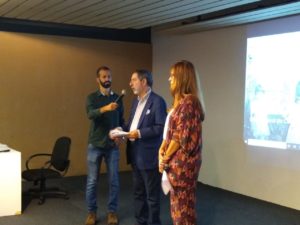In a partnership with the Arab Brazilian Chamber, the Immigration Museum held an event celebrating the Day of the Arab Community in Brazil on Saturday (26). The program featured a project and a survey presentation and short-film screenings, as well as many tales of immigration.
On Saturday (26) the Immigration Museum in São Paulo was the venue for Arab descendants to look back at the stories of their ancestors. The museum held in partnership with the Arab Brazilian Chamber of Commerce (ABCC) an event celebrating the Day of the Arab Community in Brazil, whose official date is March 25.
The program featured the launch of a link that provides access to records of the history of Arab immigration, the presentation of data from a survey on the Arab presence in Brazil, and the screening of short films. The focus of the event was the recollection of life stories of parents and grandparents. They were present both in documentaries and speeches by the leaders and members of the projects presented.
Unlike the Europeans, who came to Brazil with government subsidies to work in farms, the Arabs moved here on their own, especially in search of opportunities. Most of them worked with commerce. The date of the Day of the Arab Community in Brazil was chosen after the name of the 25 de Março Street in São Paulo, where they established their first shops.
In the event at the museum, ABCC president Osmar Chohfi told a brief story about his two grandfathers who came to Brazil from Syria, where they were peddlers. One of them opened a store, while the other first worked as a traveling salesman. “All of us Syrian and Lebanese and Palestinian descendants have stories similar to my families’,” he said.
ABCC cultural director Silvia Antibas also recalled facts from her own family. Her father’s suitcase from when he was a traveling salesman had been donated to the Immigration Museum. She said that upon arrival, an immigrant would receive instructions on the local currency and goods to sell. “My father did that when he was seven. He was told about the currency and set off to sell balloons. He had landed in Niterói,” she said.
The coordinator of the Digitization Project of the Memory of Arab Immigration in Brazil, Heloisa Dib, called the attendees to help keep the stories of immigration alive by preserving pictures, documents and journals. The materials contain information on how the immigrants traveled, how they lived in their countries of origin, what they did back there. “We only know what they told us, and that was not much,” she says.
The attendees got to learn the size of the Arab community in Brazil. ABCC and H2R Pesquisas Avançadas director Alessandra Frisso said they account for 6% of the Brazilian population and amount to 12 million people. The data comes from a survey carried out by H2R and research firm IBOPE Inteligência commissioned by the ABCC. The Arabs and descendants play a leading role in the Brazilian society, the survey says. Amongst the leaders of associations in Brazil, the Arabs account for 26%.
Launch of project
The event marked the official launch of the access to 100,000 pieces digitized by the Digitization Project of Arab Immigration in Brazil. They are pictures and journal pages created by the first Arab immigrants to Brazil that were digitized by the project. Researchers and interested parties can access the collection catalog on this link and request the materials by sending an email to reference@usek.edu.lb.
The initiative is part of a project by the Holy Spirit University of Kaslik (USEK) in Lebanon aimed at preserving the memory of Arab immigration in Latin America through the Latin American Studies and Cultures Center (CECAL) directed by historian Roberto Khatlab. In Brazil, USEK has partnered up with the ABCC to take the project forward. The access to the collection of materials from other countries in Latin America is open, too.
Films
In the short-film screenings the attendees got to know more about the history of Arab immigration in Brazil. The films brought stories about Arab ancestors and the history of immigration. The films were selected in a contest held by the ABCC. On Sunday, as part of the celebration, the play Cartas libanesas [Lebanese Letters] will stream on the YouTube channel of the Immigration Museum.
Immigration Museum
Immigration Museum executive director Alessandra Almeida said she hopes that the partnership with the ABCC in the celebrations of the Day of the Arab Community in Brazil goes on. “I hope that in the coming years we continue to host this event, given the celebration that the Arabs have given to the development of Brazil,” she said.
The Immigration Museum’s Research, Preservation and Reference Center manager Henrique Trindade Abreu said that the Arabs weren’t so present at the Immigrant Inn – a building in São Paulo that used to welcome the immigrants to São Paulo and now hosts the museum – but hundreds of them stayed there.
Translated by Guilherme Miranda
source/contents: anba.com.br (edited)
___________

__________
BRAZIL